1994 CHEVROLET CORVETTE oil level
[x] Cancel search: oil levelPage 179 of 274
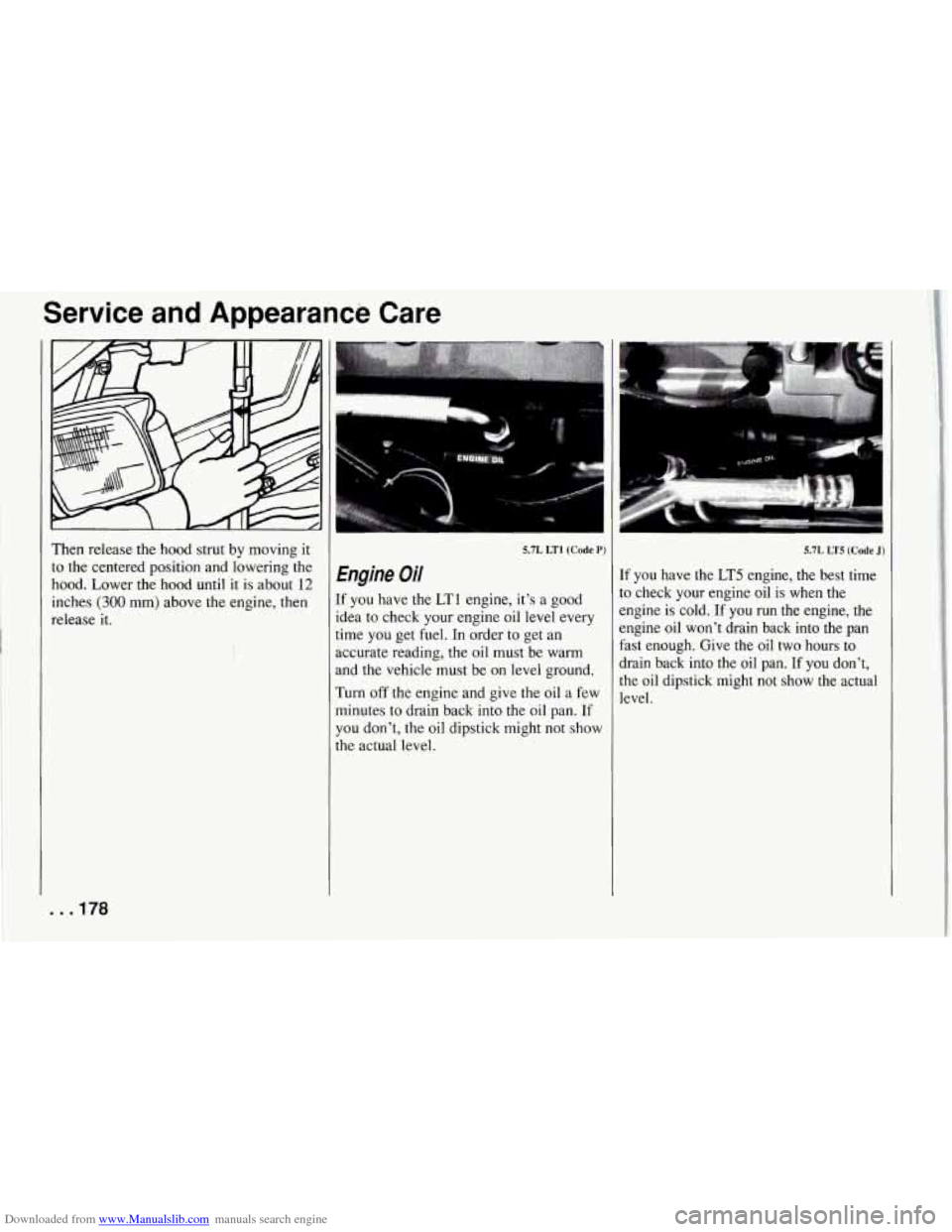
Downloaded from www.Manualslib.com manuals search engine Service and Appearance Care
Then release the hood strut by moving it
to the centered position and lowering the
hood. Lower the hood until it is about
12
inches (300 mm) above the engine, then
release it.
- - 178
I
!
5.7L LTl (Code P)
Engine Oil
If you have the LTl engine, it’s a good
idea to check your engine oil level every
time you get fuel. In order to get an
accurate reading, the oil must be warm
and the vehicle must be on level ground.
Turn off the engine and give the oil a few
minutes to drain back into the oil pan.
If
you don’t, the oil dipstick might not show
the actual level. d
tl
It
rain
le oi
:vel.
5.7L LT5 (Code J)
f you have the LT5 engine, the best time
3 check your engine oil is when the
ngine is cold. If you run the engine, the
ngine oil won’t drain back into the pan
ast enough. Give the oil two hours to
back into the oil pan. If you don’t,
1 dipstick might not show the actual
Page 180 of 274

Downloaded from www.Manualslib.com manuals search engine - ..f’.’.*.‘.*.I.
To Check Engine Oil
Pull out the dipstick and clean it with a
paper towel or cloth, then push it back
in
all the way. Remove it again, keeping the
tip lower.
5.7L LTl (Code E
When to Add Oil:
If the oil is at or below the “ADD’ mark,
you’ll need to add some oil. But you musl
use the right kind. This section explains
what kind
of oil to use. For crankcase
capacity, see “Capacities and
Specifications” in the Index.
NOTICE:
Don’t add too much oil. If your
engine has
so much oil that the oil
level gets above the upper mark that
shows the proper operating range,
your engine could be damaged.
5.7L LT5 (Code J)
Just fill it enough to put the level
somewhere
in the proper operating range.
Push the dipstick all the way back
in
when you’re through.
What Kind of Oil to Use
Look for two things:
GM4718M
The Corvette engine requires a special
oil meeting GM Standard GM47 18M.
Oils meeting this Standard may be
identified as synthetic. However, not
all SYNTHETIC oils will meet this
GM Standard. You should look
for
and use only an oil that meets GM
Standard GM47 18M.
179 ...
Page 182 of 274
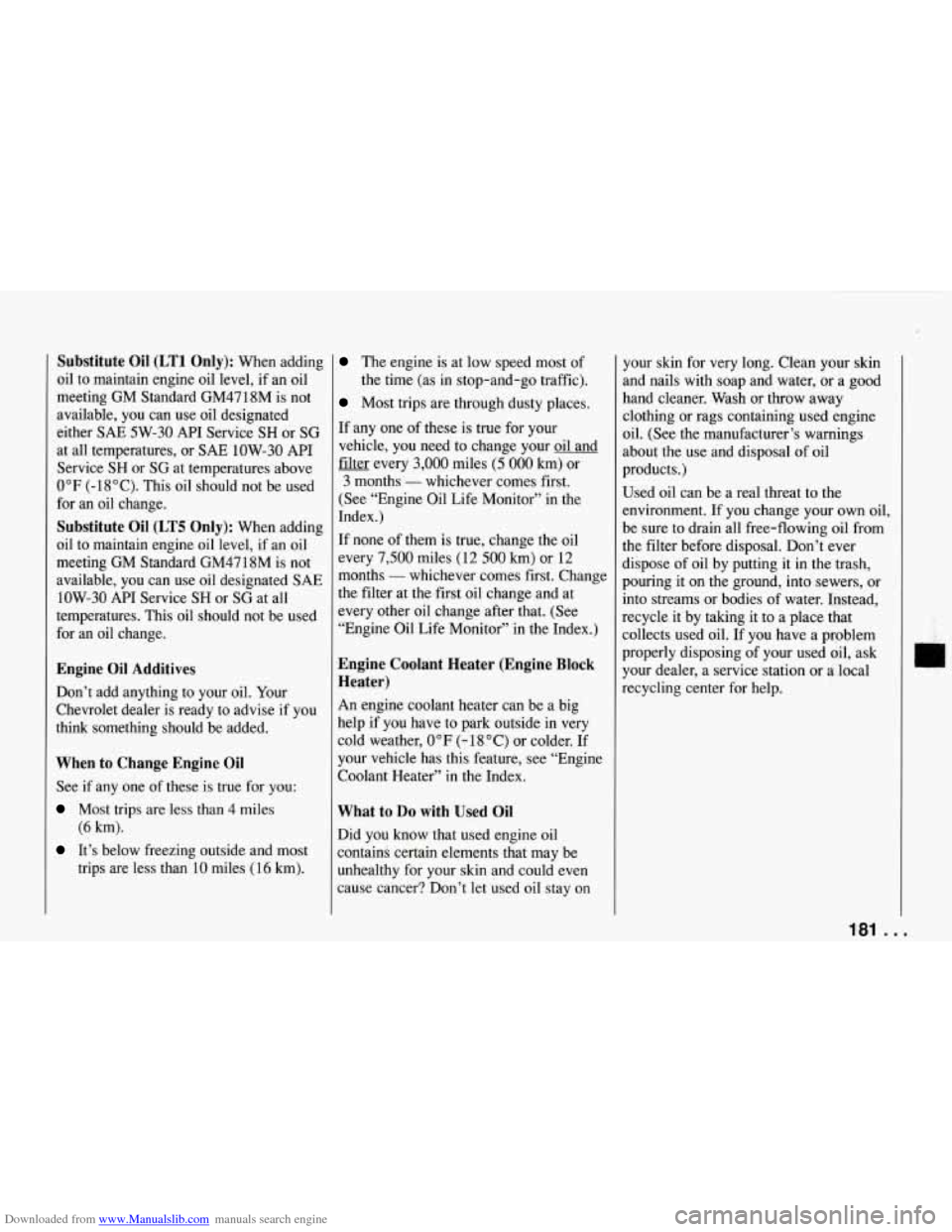
Downloaded from www.Manualslib.com manuals search engine Substitute Oil (LT1 Only): When adding
oil to maintain engine oil level, if an oil
meeting GM Standard GM4718M is not
available, you can use oil designated
either
SAE 5W-30 API Service SH or SG
at all temperatures, or
SAE 1OW-30 API
Service
SH or SG at temperatures above
0°F (-18°C). This oil should not be used
for an oil change.
Substitute Oil (LT5 Only): When adding
oil to maintain engine oil level, if an oil
meeting
GM Standard GM4718M is not
available, you can use oil designated SAE
1OW-30 API Service SH or
SG at all
temperatures. This oil should not be used
for an oil change.
Engine Oil Additives
Don’t add anything to your oil. Your
Chevrolet dealer is ready to advise if you
think something should be added.
When to Change Engine Oil
See if any one of these is true for you:
Most trips are less than 4 miles
It’s below freezing outside and most
trips are less than
10 miles (16 km).
(6 km).
The engine is at low speed most of
the time (as
in stop-and-go traffic).
Most trips are through dusty places.
If any one of these is true for your
vehicle, you need to change your oil and
filter every 3,000 miles
(5 000 km) or
3 months
- whichever comes first.
(See “Engine Oil Life Monitor” in the
Index.)
If none of them is true, change the oil
every 7,500 miles
( 12 500 km) or 12
months
- whichever comes first. Change
the filter at the first oil change and at
every other oil change after that. (See
“Engine Oil Life Monitor” in the Index.)
Engine Coolant Heater (Engine Block
Heater)
An engine coolant heater can be a big
help if you have to park outside in very
cold weather,
0 “F (- 18 “C) or colder. If
your vehicle has this feature, see “Engine
Coolant Heater” in the Index.
What to Do with Used Oil
Did you know that used engine oil
contains certain elements that may be
unhealthy for your skin and could even
cause cancer? Don’t let used oil stay on your
skin for very long. Clean your skin
and nails with soap and water, or a good
hand cleaner. Wash or throw away
clothing or rags containing used engine
oil. (See the manufacturer’s warnings
about the use and disposal of oil
products.)
Used oil can be a real threat to the
environment. If you change your own oil,
be sure to drain all free-flowing oil from
the filter before disposal. Don’t ever
dispose of oil by putting it in the trash,
pouring it on the ground, into sewers, or
into streams or bodies of water. Instead,
recycle
it by taking it to a place that
collects used oil. If you have a problem
properly disposing of your used oil, ask
your dealer, a service station or
a local
recycling center for help. L 1
181 ...
Page 185 of 274

Downloaded from www.Manualslib.com manuals search engine Service and Appearance Care
5.
0
0
Reverse the steps.
Align the tabs
to the slots in the
bottom of the assembly before you
replace it.
Install the short knob into the middle
hole first. Then install the longer
knobs into the outer holes.
Automatic Transmission Fluid
When to Check and Change
4 good time to check your automatic
:ransmission fluid level is when the
mgine oil is changed. Refer to the
Maintenance Schedule to determine when
co change your fluid. See “Scheduled
Maintenance Services” in the Index.
How to Check
Because this operation can be a little
iifficult, you may choose to have this
done at a Chevrolet dealership Service
Department.
[f you do it yourself, be sure to follow all
the instructions here, or you could get a
false reading on the dipstick.
NOTICE:
Too much or too little fluid can dam-
age your transmission.
Too much can
mean that some of the fluid could
come out and fall
on hot engine parts
or exhaust system, starting a fire. Be
sure to get an accurate reading if you
check your transmission fluid. Wait
at least 30 minutes before checking
the transmission fluid level if you have
been driving:
0 When outside temperatures are above
0 At high speed for quite a while.
0 In heavy traffic - especially in hot
To get the right reading, the fluid should
be at normal operating temperature, which is
180°F to 200°F (82°C to 93°C).
To check transmission fluid hot: Get
the vehicle warmed up by driving
about
15 miles (24 km) when outside
temperatures are above
50°F (10°C). If
it’s colder than
50°F (10°C)’ drive the
vehicle in
“D’ (Third Gear) until the
engine temperature gage moves and then
remains steady for ten minutes. Then follow the hot check procedures.
To check transmission fluid cold: A cold
check is made after the vehicle has been sitting for eight hours or more with the
engine
off and is used only as a reference.
Let the engine run at idle for five minutes
if outside temperatures are 50” F ( 1 OOC)
or more. If it’s colder than 50°F ( 10°C)’
you may have to idle the engine longer.
Should the fluid level be low during a
90°F (32°C).
weather.
. . .184
Page 189 of 274
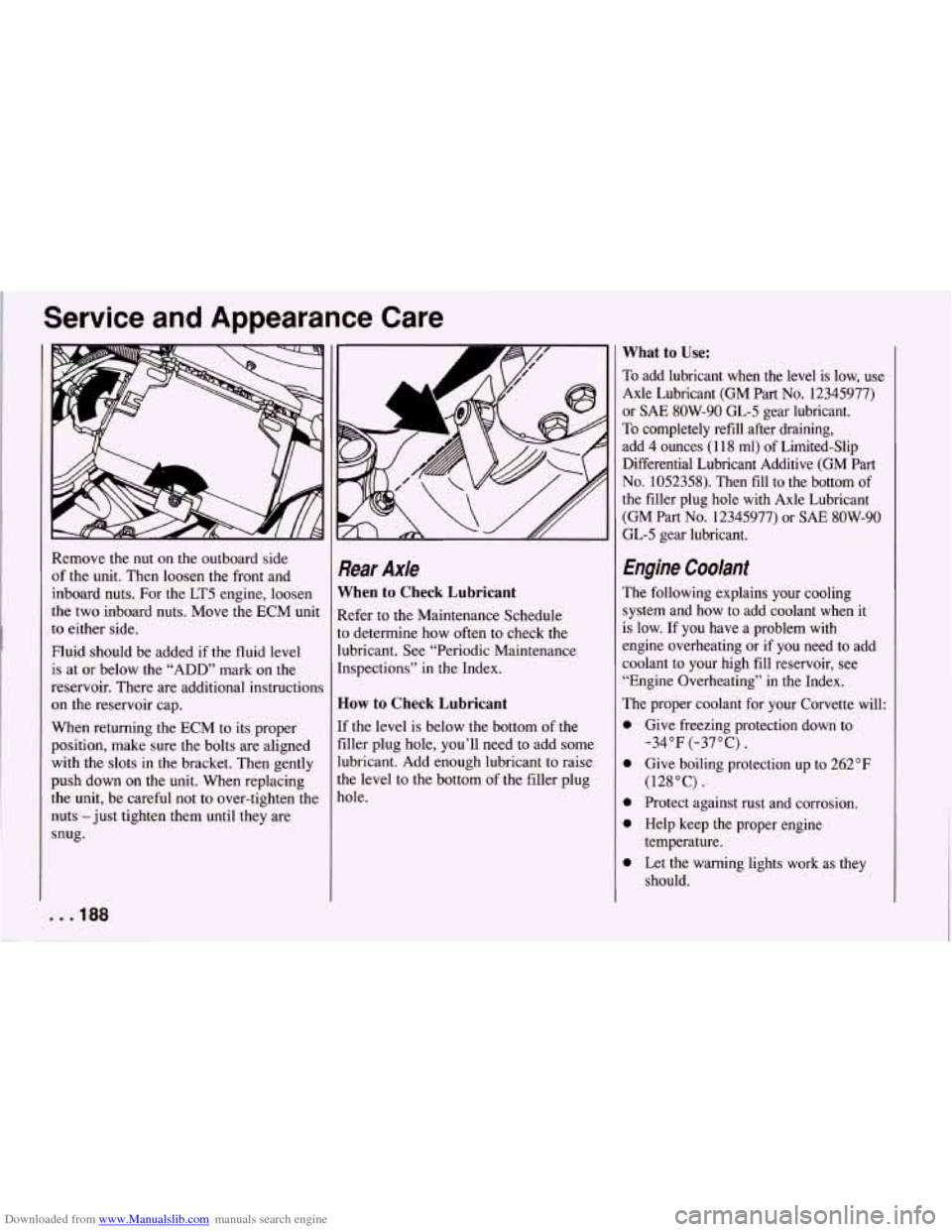
Downloaded from www.Manualslib.com manuals search engine Service and Appearance Care
Remove the nut on the outboard side
of the unit. Then loosen the front and
inboard nuts. For the LT5 engine, loosen
the two inboard nuts. Move the ECM unit
to either side.
Fluid should be added if the fluid level
is at or below the “ADD” mark on the
reservoir. There are additional instructions
on the reservoir cap.
When returning the ECM to its proper
position, make sure the bolts are aligned
with the slots in the bracket. Then gently
push down on the unit. When replacing
the unit, be careful not to over-tighten the
nuts -just tighten them until they are
snug.
. . * 188
Rear Axle
When to Check Lubricant
Refer to the Maintenance Schedule
to determine how often to check the
lubricant. See “Periodic Maintenance
Inspections” in the Index.
How to Check Lubricant
If the level is below the bottom of the
filler plug hole, you’ll need to add some
lubricant. Add enough lubricant to raise
the level to the bottom of the filler plug
hole.
What to Use:
To add lubricant when the level is low, use
Axle Lubricant (GM Part
No. 12345977)
or
SAE 8OW-90 GL-5 gear lubricant.
To completely refill after draining,
add 4 ounces (1 18 ml) of Limited-Slip
Differential Lubricant Additive (GM Part
No. 1052358). Then fill to the bottom of
the filler plug hole with Axle Lubricant
(GM Part
No. 12345977) or SAE 8OW-90
GL-5 gear lubricant.
Engine Coolant
The following explains your cooling
system and how to add coolant when
it
is low. If you have a problem with
engine overheating or
if you need to add
coolant to your high fill reservoir, see
“Engine Overheating” in the Index.
The proper coolant for your Corvette will:
0
0
0
0
0
Give freezing protection down to -34°F (-37°C).
Give boiling protection up to 262°F
(128°C).
Protect against rust and corrosion.
Help keep the proper engine
temperature.
Let the warning lights work as they
should.
Page 230 of 274
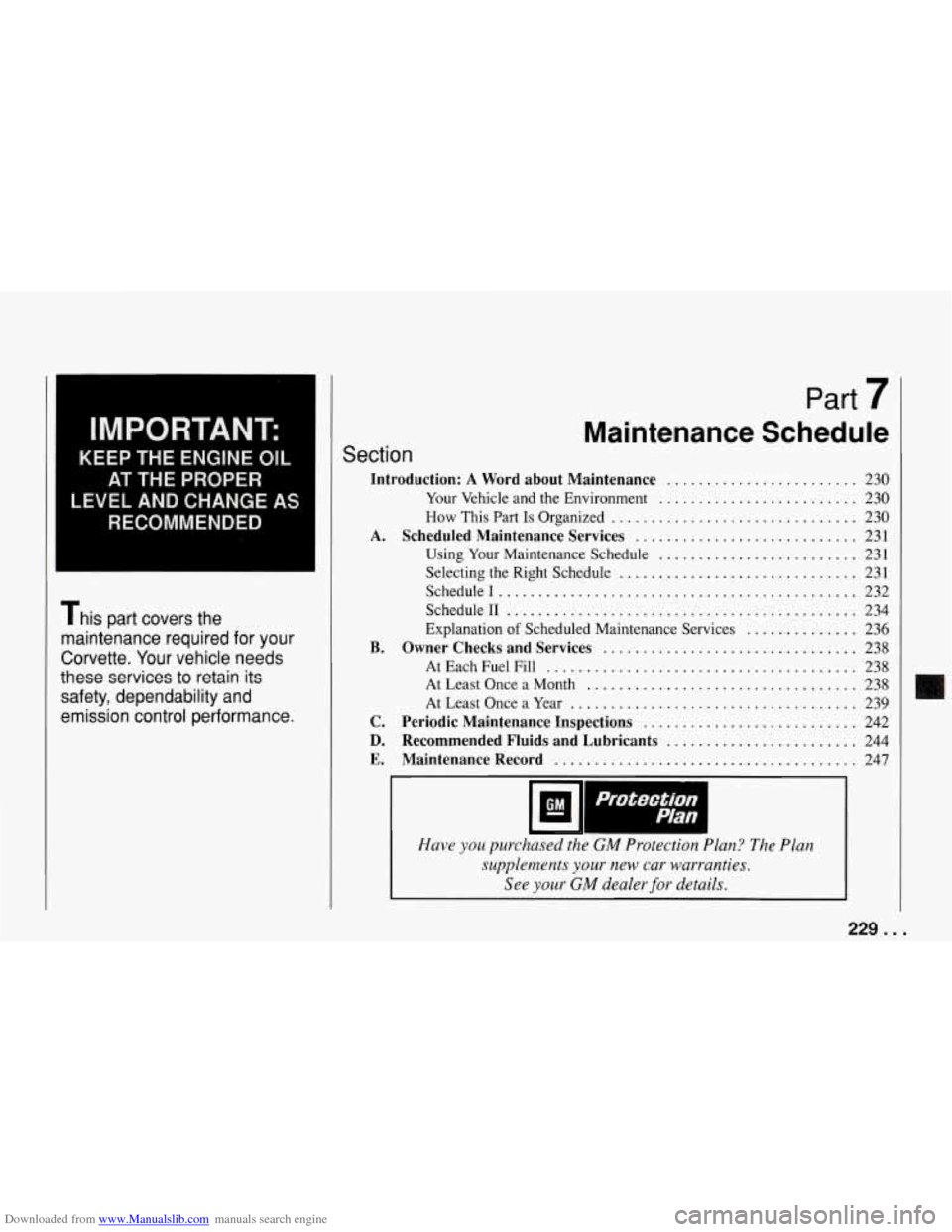
Downloaded from www.Manualslib.com manuals search engine IMPORTANT:
KEEP THE ENGINE OIL
AT THE PROPER
LEVEL AND CHANGE AS
RECOMMENDED
This part covers the
maintenance required for your
Corvette
. Your vehicle needs
these services to retain its
safety. dependability and
emission control performance
.
.
Maintenance Schedule
Section
Introduction: A Word about Maintenance ........................ 230
A .
B .
C .
D .
E .
Your Vehicle and the Environment ......................... 230
How This Part Is Organized ............................... 230
Scheduled Maintenance Services ............................ 231
Using Your Maintenance Schedule
......................... 231
Selecting the Right Schedule
.............................. 231
Schedule1
............................................. 232
Schedule11
............................................ 234
Explanation
of Scheduled Maintenance Services .............. 236
Owner Checks and Services ................................ 238
At Each Fuel
Fill ....................................... 238
AtLeastOnceaMonth
.................................. 238
At Least Once
a Year .................................... 239
Periodic Maintenance Inspections ........................... 242
Recommended Fluids and Lubricants ........................ 244
Maintenance Record ...................................... 247
I
Protection
Plan
Have you purchased the GM Protection Plan? The Plan
supplements your new car warranties
.
See your GM dealer for details .
229 ...
Page 238 of 274

Downloaded from www.Manualslib.com manuals search engine ITEM
NO. SERVICE
Index. This provides proper
freeze and boil protection,
corrosion inhibitor level and
maintains proper engine
operating temperature.
Inspect hoses and replace if
they are cracked, swollen or
deteriorated. Tighten screw-type
hose clamps. Clean the outside of
the radiator and air conditioning
condenser. Wash the pressure cap
and neck.
To help ensure proper operation,
we recommend a pressure test of
both the cooling system and the
pressure cap.
5 Transmission Service - For
manual transmissions, fluid
doesn’t require changing. See
“Periodic Maintenance
Inspection.”
For automatic transmissions,
change both the fluid and filter
every
15,000 miles (25 000 km)
ITEM
NO. SERVICE
if the vehicle is mainly driven
under one or more of these
conditions:
In heavy city traffic where the
outside temperature regularly
reaches
90 OF (32 O C) or
higher.
In hilly or mountainous
terrain.
Uses such as found in taxi,
police car or delivery service.
If you do not use your vehicle
under any of these conditions,
change both
the fluid and
filter every
100,000 miles
(1 66 000 km).
Replace spark plugs with the
proper type. See “Replacement
Parts” in the Index.
6 Spark Plug Replacement* -
7 Spark Plug Wire Inspection*? -
Inspect for burns, cracks or other
damage. Check the boot fit at the
coils and at the spark plugs.
Replace wires as needed.
ITEM
NO. SERVICE
8 Air Cleaner Filter Replacement*-
Replace every
30,000 miles
(50 000 km) or more often under
dusty conditions. Ask your dealer
for the ’proper replacement inter-
vals for your driving conditions.
Inspection*?
- Inspect fuel tank,
cap and lines (including fuel rails
and injection assembly) for
damage or leaks. Inspect fuel cap
gasket for an even filler neck
imprint or any damage. Replace
parts as needed. Periodic replace-
ment of the fuel filter is not
required.
9 Fuel Tank. Cap and Lines
* An Emission Control Service.
t The U.S. Environmental Protection Agency
or the California Air Resources Board has
determined that the failure to perform this
maintenance item will not nullify the emission
warranty or limit recall liability prior to the
completion
of vehicle useful life. General
Motors, however, urges that all recommended
maintenance services be performed at the
indicated intervals and the maintenance be
recorded in “Section
E: Maintenance Record.”
I -I
237. . .
Page 239 of 274
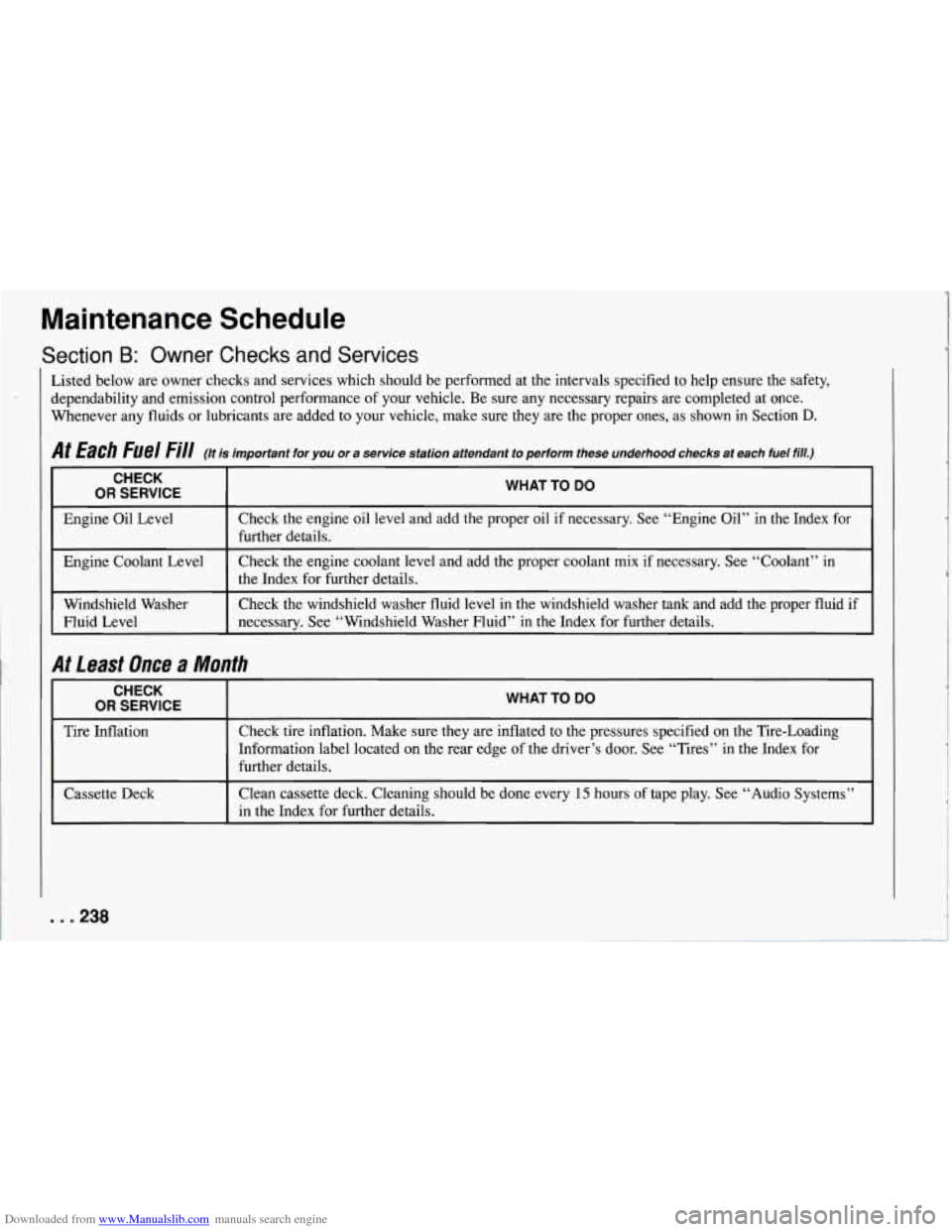
Downloaded from www.Manualslib.com manuals search engine Maintenance Schedule
Section B: Owner Checks and Services
isted below are owner checks and services which should be performed at the intervals specified to help ensure the safety,
ependability and emission control performance of your vehicle. Be sure any necessary repairs are completed at once.
Vhenever any fluids or lubricants are added
to your vehicle, make sure they are the proper ones, as shown in Section D.
If Each Fuel Fill (/t is important for you or a service station attendant to perform these underhood checks at each fuel fill.)
i CHECK
OR SERVICE I WHAT TO DO
Engine Oil Level
Check the windshield washer fluid level in the windshield washer
tank and add the proper fluid if
Windshield Washer Check
the engine coolant level and add the proper coolant mix if necessary. See “Coolant” in
Engine Coolant Level Check the
engine oil level and add the proper oil if necessary. See “Engine Oil” in the Index for
Fluid Level necessary.
See “Windshield Washer Fluid” in the Index for further details.
further details.
the
Index for further details.
It Least Once a Month
CHECK
OR SERVICE
Tire Inflation
Cassette Deck
WHAT TO DO
Check tire inflation. Make sure they are inflated to the pressures specified on the Tire-Loading
Information label located on the rear edge
of the driver’s door. See “Tires” in the Index for
further details.
Clean cassette deck. Cleaning should be done every
15 hours of tape play. See “Audio Systems”
in the Index for further details.
. .238